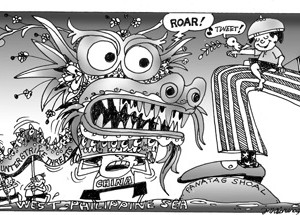The 25th anniversary of the National Commission for Culture and the Arts was marked last June 26, and it is proper to recharge memory on its birthing.
The original impetus of the creation of the NCCA was embodied in Senate Bill No. 205 authored by then Sen. Heherson Alvarez and filed on Nov. 18, 1987, “to call attention to culture and arts as the crux of national development.” The cosponsors were then senators Edgardo Angara, Joseph Estrada, and Santanina Rasul. It was focused on democratizing the right to culture and the arts which, Alvarez said, are “the most valuable, powerful and inexhaustible resources of our country.”
Then Sen. Benigno “Ninoy” Aquino Jr. once rose to deliver a privilege speech objecting to the use of the multimillion-peso war veterans’ education fund for the construction of the Cultural Center of the Philippines which he called “a pantheon for Imelda.” Alejandro Roces, a former education secretary and then chair of Unesco, joined Ninoy in a Senate inquiry led by then Sen. Eva Kalaw, who chaired the Senate committee on education. The cause won in a free press where Marcos conceded to implement Republic Act No. 4165 passed during Diosdado Macapagal’s presidency. But the victory was short-lived because the Culture Commission Law of 1964 was set aside. What prevailed was a presidential executive order giving the CCP total control of cultural policy and programs.
“When Ninoy Aquino’s martyrdom led to our national liberation, the Edsa event in 1986 signified the advent of a climate congenial to creativity of the Filipino that will allow his imaginative energies to work wonders as the matrix for our economic, political, social progress,” Alvarez said. Under a restored democracy, when SB 205 went through first reading in 1987, certain sectors feared that the creation of independent funding for the arts would make the CCP lose its “primus inter pares” position as a cultural institution and its priority access to public funding.
Then Sen. Leticia Shahani’s support was sought, and she authored a parallel bill which was filed as SB 303 on March 18, 1988. The committee on education and culture chaired by Angara eventually consolidated the two bills into SB 1492 in 1990.
Even before the bill’s approval, Alvarez sought and got support from Pagcor and the tourism department to seed and sustain the National Endowment Fund for Culture and the Arts.
In his sponsorship speech at the bill’s final presentation in the Senate, Alvarez said: “We must not only invest in bridges and roads, buildings and factories but also in artists who can build bridges between peoples and their vision and roads to our future. We dedicate this bill to Ninoy’s vision of a free society which allows the full expression of culture and conscience to usher a renaissance of the Filipino spirit and the flowering of Filipino genius.”
The counterpart House Bill No. 35379 was filed through the initiatives of Rep. Carlos Padilla and Rep. Narciso Monfort. President Corazon Aquino signed the bill into law on April 3, 1992.
Senate records will validate this narrative. Historical accuracy must recognize the roles of the main advocates in the birthing of the NCCA. The arts must embrace truth, which sets everyone free.
—CHOLA COLAYCO NAVARRO,
chief of staff of Heherson Alvarez
during his first Senate term


